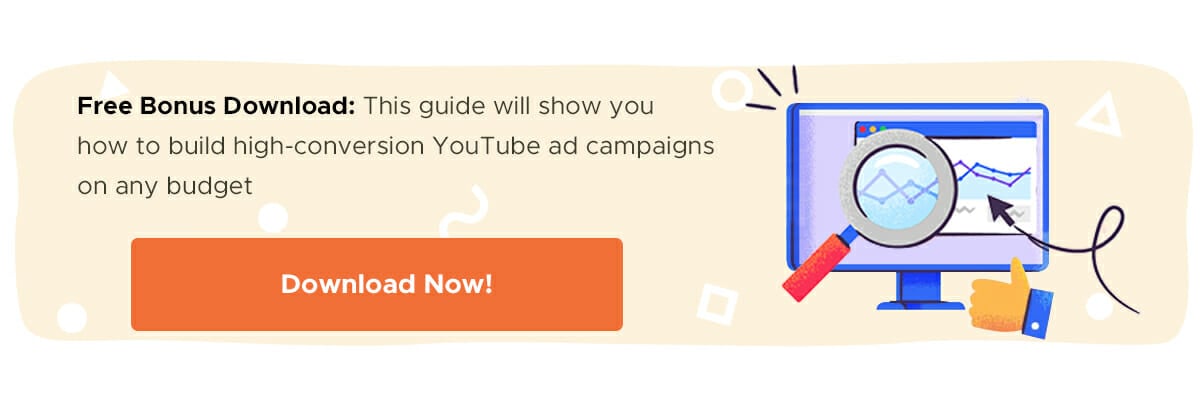Professional networking site LinkedIn has long been an effective outlet for businesses – especially B2B ones – to connect with potential hires, partners and, most importantly, customers. The best part? You don’t have to pay for those connections.
Unfortunately, it looks like the golden days of LinkedIn marketing are drawing to a close. With more than 630 million members – 303 million of which are monthly active users – and Microsoft’s (which bought LinkedIn at the end of 2016) acquisition of Drawbridge to grow LinkedIn’s Marketing Solutions product, the network appears to now be focused aggressively on growth. And that means marketers are going to have to revise their strategies for the platform.
Facebook is basically an ad network for brands now, and although LinkedIn isn’t there yet, it’s definitely moving in a pay-to-play direction.
We plan on milking the last bit of organic reach that LinkedIn has to offer before it’s gone, and you should, too.
The Evolution of LinkedIn’s Algorithm
Initially, LinkedIn’s algorithm favored text posts and articles, and then as users began uploading videos, the algorithm shifted, just as Facebook’s did when they began promoting native video.
Engagement became a huge factor as well, as business influencer posts started to show up more frequently than those of less-well-known professionals. This led to some complaints that LinkedIn power users were crowding the feeds, and smaller brands and individuals wound up struggling to get eyes on their posts.
Then in late 2018, LinkedIn changed how engagements were scored, weighing how much each “like” would actually mean to the user. For example, a “like” wouldn’t mean that much to Bill Gates or Richard Branson, but it would mean something entirely different to someone with just a few hundred connections:
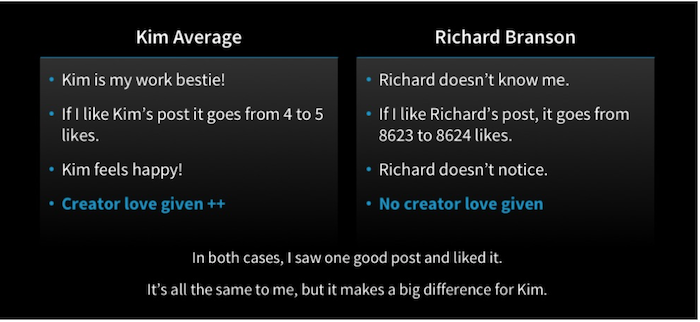
This led to a slight decrease in power users in the feed, and slightly more of a user’s actual connections showing up.
Dive Deeper: How to Use Dux Soup & LinkedIn to Scale Your Sales and Recruiting Efforts
Organic Reach Is Declining on LinkedIn
It’s not just your LinkedIn connections and business influencers who are competing for feed space. Business ads and LinkedIn house ads have been slowly increasing in the feed over time. And it’s paid off for Microsoft – their last earnings report cited LinkedIn as one of the primary drivers of their 12% growth in revenue.
What all this means is less organic reach for content creators. Neil Patel, for example, has seen his video views drop by about 50% as LinkedIn’s algorithm has started becoming more and more like Facebook’s.
It all comes down to incentives. Think back to Charlie Munger’s famous speech in 1995 on The Psychology of Human Misjudgment, where he talks at length about the impact of incentives (in economic terms, the financial motivations for people to take certain actions):
In LinkedIn’s case, the network prioritized releasing new content types to incentivize members to use the app and website more frequently. As users get more engagement and followers, they have more incentive to keep coming back. Once LinkedIn has enough people logging on every day and creating content, they have a vehicle for monetization. And like Facebook, they’re starting to limit that reach in the hopes that users will pay for it.
Dive Deeper: The Ultimate Guide to Creating a LinkedIn Ads Campaign
Should You Pay for LinkedIn Ads?
The two most important things to know about LinkedIn Ads is that they are:
- effective (especially for B2B brands)
- expensive (for everyone)
If you have the budget for it and you know what works, then yes, you should absolutely run some paid ads on the network.
That said, you don’t have to decide just yet on whether to budget for LinkedIn Ads. The organic reach situation on LinkedIn isn’t quite as dire as it is on Facebook, where you need to boost a post if you want anyone to see it.
You can still use LinkedIn as a marketing tool – you just need to be realistic about your expectations for the present and the future. You won’t get the reach you got last year, and next year you’ll have much less reach than you do today. And there’s nothing you can do about it unless you want to pay for more eyeballs.
Dive Deeper: Omnichannel Marketing: Using the Content Sprout Method to Overcome Info Overload
Focus on Omnichannel Marketing Instead
We talk about omnichannel marketing a lot around here, and it’s because we believe it’s the best way to get your content seen. Information overload is real, and you better believe that your target audience has it. The more channels you can distribute content to, the more likely it is that a potential client or customer will see it.
We don’t pay to play on LinkedIn. We’ve done it in the past, and the ROI just isn’t there for us. I post about once per day on my LinkedIn (usually a video):
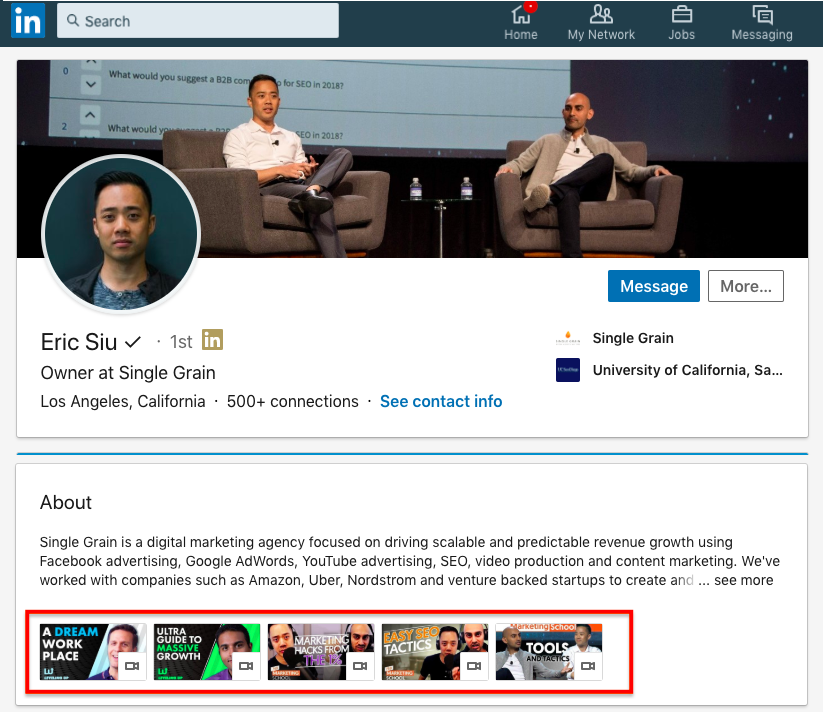
And we push all our blog content out on Single Grain’s LinkedIn page. But we also post on Facebook, Twitter, YouTube and this blog. And I create podcasts. So, if I only get 100 views on a video I post to LinkedIn, I’m still getting views and engagements across all channels, and they add up.
Another advantage of omnichannel marketing is that you never know which channel is going to knock your legs out from under you. It happened with Facebook. Many publishers and brands went from getting the majority of their traffic from Facebook to nothing overnight. And I know people who have gone all-in on LinkedIn who are in a similar situation. You can’t depend on one channel for your traffic because you don’t know how long that channel is going to work to your advantage.
Omnichannel means more than just being on every social media network and distributing content that way. You should have some channels that you own in the mix. This blog is a channel that we own. Our email list is a channel that we own. Same with our podcasts. We have total control over those channels. So, if we’re a spider, and one leg – in this example, LinkedIn – gets cut off, we still have seven more legs.
Going omnichannel doesn’t mean you have to create unique content for every channel, every day. It means taking your best content and repurposing it on different channels. For example, I talk a lot about our Content Sprout Method, which is a 3-step process for repurposing and disseminating content:
- Seed: Identify your content that is popular, comprehensive and meaty enough to be chopped up into different content types. If you don’t already have this, create it.
- Sprout: Take that content and turn it into different types. For example, a longer YouTube video can be cut into several quick-tip videos for Instagram. This blog post is a lengthier dive into a topic we covered on a recent episode of Marketing School.
- Pollinate: Offer users incentives to improve engagement on the top-performing pieces of content. This can be a reward, like a special offer.
Get the Most Out of LinkedIn While You Still Can
Even if you aren’t getting the same reach on LinkedIn, it’s still important to have an active presence on the network. Follow these tips and best practices to squeeze out every last bit of organic reach while you still can.
1) Create Native Video
LinkedIn loves video content, and it especially loves video content that lives on the site (as opposed to a link to something on YouTube). If you can, experiment with creating some quick-tip videos to post to your profile. You don’t need to have a studio or a production team to do this. A webcam or a phone will do the trick. Just make sure the lighting is decent and that there’s no background noise.
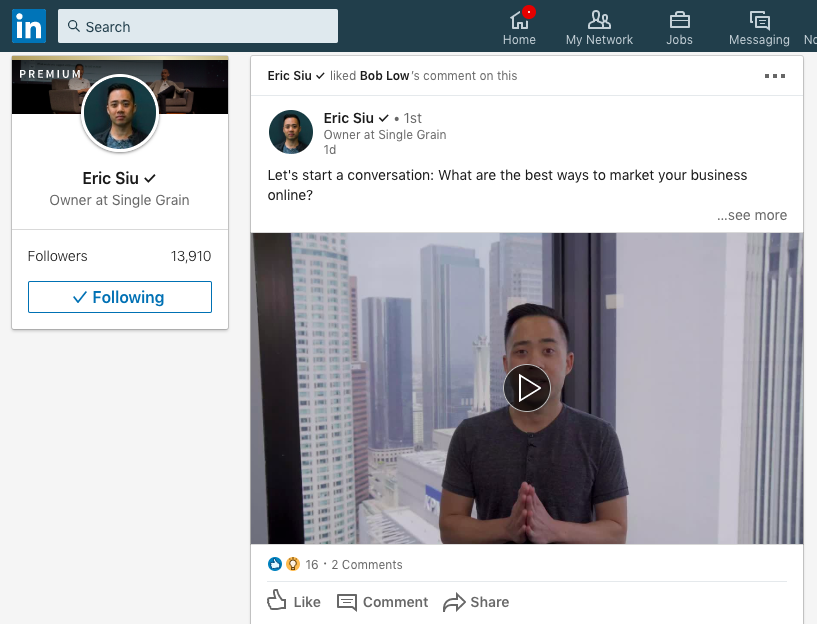
In terms of topics, go back to the Content Sprout Method. Find out what really resonates with your target audience. Are they looking for SEO tips? Divide your best ones into 1-2 minute videos.
Dive Deeper: Live Streaming Videos: The Most Powerful Way to Share Content
2) Leverage Your Network
Every employee at your company should be engaging with the content you put out there. When you post something, email your staff and ask them to like, comment and share your posts. This is an easy way to grow your engagement and get a boost in organic reach.
3) Copy the Influencers
As LinkedIn updates their algorithm, the content that gets pushed to the top will change. But you can look at what’s getting the reach and figure out how to make it work for you.
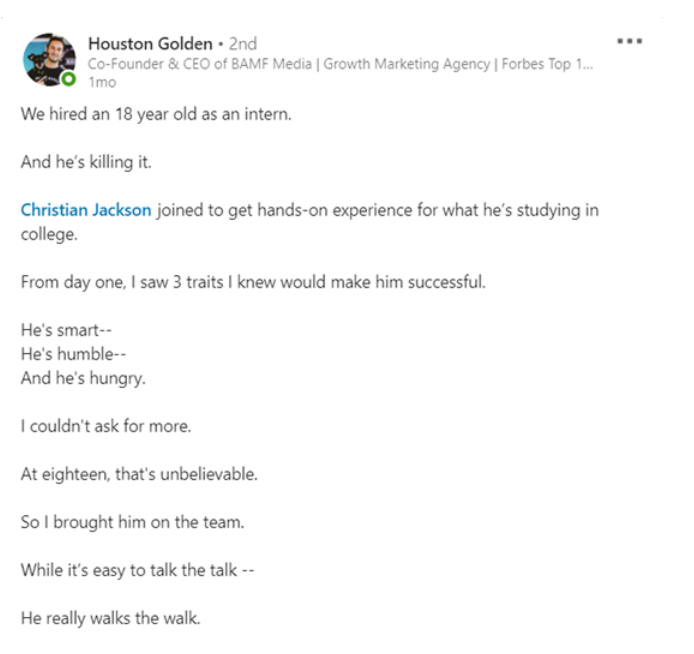
For a while, the posts that Buzzfeed called “broetry” – the long posts where each sentence is its own paragraph and the message is personal improvement – were clogging up everyone’s feed. There was also a brief period of time when political opinions were getting a lot of feed space (related tip: don’t post political opinions on LinkedIn).
Those don’t get so much play anymore. We’ve been seeing a lot more storytelling with compelling visuals or shared articles with meaty commentary. Tomorrow it will probably be something different, so pay attention to these changes.
Dive Deeper: How to Choose an Influencer to Boost Your Marketing Campaign
4) Don’t Post Too Much
Remember: you want engagement. If you post 10 times each day, your potential engagement gets spread out across all those posts and they’ll never get the reach. If you post once, you have a good chance of getting enough likes and comments that your post will get a boost.
It will take some experimenting to see what the right number is for you. I’ve found that once per day works pretty well for me. Start with one, then slowly add. When engagement starts to go down, you’ll know you went too far.
5) Post at the Right Time
There are countless articles out there that claim to tell you what the best days and times are to post on LinkedIn. Ignore them. They only tell you what the general trends are on LinkedIn, not what’s happening in your industry.
Try posting at different times to see what resonates with your audience. And if you’re getting your staff on board too, try to sync up when they like and share so you can get an idea of how that engagement is giving you a boost.
6) Create Valuable Content
Don’t create content just to have something to post. LinkedIn favors content that is relevant to your industry, comes from a credible source, and offers career advice or tips.
As a data point, OkDork analyzed thousands of LinkedIn posts and found that long-form content (between 1,900-2,000 words) got the most views, as well as content that explained how something works or was in list form.
7) Engage with Other People’s Content
Interacting with high-profile people in your industry will help raise your profile as well, which, again, means more followers and more engagement. It’s a win-win.
Getting Your Message Out on LinkedIn
LinkedIn has changed and it will continue to change until it’s another Facebook, where you have to pay to get any sort of leverage. But we’re not there yet. Focus on creating content that is valuable to your target audience and use it to grow your engagement, followers and – most importantly – your business.
But remember that LinkedIn is only one channel in your marketing strategy. It shouldn’t be your primary focus – no social media network should be – because it’s always changing and you can’t predict how well it will work for you down the road. The bulk of your time and resources should still go into your owned channels, like your blog, email list or podcasts. They’ll only change if you decide to change them.
